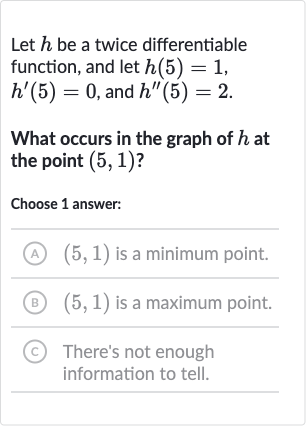Full solution
Q. Let be a twice differentiable function, and let , , and .What occurs in the graph of at the point ?Choose answer:(A) is a minimum point.(B) is a maximum point.(C) There's not enough information to tell.
- Analyze Given Information: To determine what occurs at the point on the graph of , we need to analyze the given information about the function and its derivatives at .
Given:
, which means the point lies on the graph of .
, which indicates that the slope of the tangent to the graph of at is zero. This means that the graph has a horizontal tangent line at .
, which tells us that the concavity of the graph of at is upwards since the second derivative is positive. - Interpret First Derivative: Using the information from the first derivative, , we know that the point could be a local maximum, a local minimum, or a point of inflection. However, we cannot conclude which one it is based solely on the first derivative.
- Determine Concavity: The second derivative, , is positive, which means the graph of is concave up at . In the context of the first derivative being zero, this indicates that the point is a local minimum because the graph is shaped like a "U" at that point.

